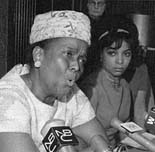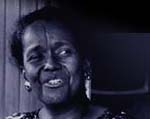By Sam Omatseye
Rosa Parks may have been the spark plug of the Civil Rights Movement, but before Parks, there was Ella Baker, a kind of Cinderella of the struggle for several decades.
Obscured by her gender, the flamboyance of other leaders like Martin Luther King, Jr., and her retreat from the national limelight, Baker’s contributions to the civil rights triumphs are not well known.
She was the humble planter of the movement. She put together the nuts and bolts by organizing at the grassroots, traveling from city to small town, holding meetings, writing press releases, shaping strategies, organizing rallies and marches, connecting groups, raising funds, consoling the bereaved, inspiring the despondent, and proselytizing to the weak. Baker was one of the powerhouses of the struggle dating back to the Harlem Renaissance in the late 1920s and early 1930s. She also worked with all of the major icons of the struggle, including Walter White, who was the head of the NAACP in the 1930s: Bayard Rustin, Rosa Parks, as well as Martin Luther King. Baker was one of the powerhouses of the struggle dating back to the Harlem Renaissance in the late 1920s and early 1930s. She also worked with all of the major icons of the struggle, including Walter White, who was the head of the NAACP in the 1930s: Bayard Rustin, Rosa Parks, as well as Martin Luther King.
She was a major player in spreading the NAACP to the far-flung reaches of the country, especially to the rural South. Baker organized the Southern Christian Leadership Conference in the aftermath of the Montgomery Bus Boycott. Her role in the founding of the Student Non-Violent Coordinating Committee, which ignited Black youth to protest and inaugurated the freedom rides and sit-ins across the nation, was unmistakable. Before these, she was field secretary and director of branches for the NAACP in the 1930s and 1940s when she brought the gospel of equality to America.
Although Baker partnered with some of the icons of the fight for freedom and equality, she was distinguished by her vision, industry and attention to detail. That set her at odds with some of the leaders, especially White and King.
She often felt that both men tended to place ego and personal prestige ahead of the movement. So her relationship with both men came to a head often after conflicts about vision, the structure of the movement, or the minutiae of administration
With King, she often complained about the Civil Rights leader’s emphasis on rhetoric over substance, the organization over the movement, central leadership over grassroots workers, and national leaders over local efforts.
“Everything was a reflection of the greatness of the individual,” she was quoted as saying in her biography, Ella Baker: Freedom Bound, by Joanne Grant. “I spoke to (King) about that, which was not very bright. And I spoke to people who were sponsoring it. When I spoke to him, he said, ‘Well, I can’t help what people do.’ ”
Baker had her critics. They saw her as a little aggressive, and this may have drawn resentment from King and other men around him, including Ralph Abernathy. Once when King was to deliver a speech on the 1957 Civil Rights Act, Baker wanted him to deemphasize the speech’s emotional quality or, if he couldn’t, give room to another speaker to break it down to the audience. King, according to Baker’s critics, did not want her to mentor him. King had a domineering mother, and so did not want to deal with that kind of personality from another woman.
But Baker had her points, too. She complained that King was not accessible, and was slow to act in some of the little details of administration. “Martin had to consult a whole lot of people before he could make up his mind,” she intoned. “Sometimes, to me, they were very small decisions that should not have necessitated the wide consultations that he felt he had to involve himself in.”
She had similar experiences with White at the NAACP. Baker said that White was more interested in membership numbers and dollars than the impact of the movement. When she worked with the NAACP, its impact was not as strong in the South, so she traveled there several times as the director of branches to expand local membership. Alone, she would enter trains, disdaining her own safety, suffering racial taunts and discrimination on the way.
This was another source of conflict between Baker, King, and Abernathy. Long before the men’s foray into the world of civil rights, Baker had decades of experience in the struggle. She knew not only the daily grind of the work but a wide variety of people, high and low.
|
|
King was more middle-class than Baker. He did not grow up in the backwoods as she did. She felt that this deficit in King’s background took away an appreciation of a grassroots approach to the struggle. She had seen the frustrations, challenges, joys, and pains of the oppressed in many more ways than the designated leaders of the struggle. This tended to push her toward a local rather national approach to the struggle. This also inclined her to play down the cult of the individual. She said she preferred a “group-centered leadership, rather than a leadership-centered group.” Baker believed that the movement should have primacy over the individual, noting that “Martin did not make the movement; the movement made Martin.”
Baker “was not church.” She did not belong to that exclusive circle of clergy who filled the ranks of the SCLC. She was not a young, attractive woman who would defer to the authority of ministers. She was an efficient organizer, however, working several hours on a variety of issues. When the SCLC was founded, she worked day and night, not only on membership drives, but also on voter registration.
Her gender was an undeniable factor in the friction. One of the contradictions of the Civil Rights Movement was that it projected an egalitarian image while within it was a strong strand of patriarchy. Baker cited two instances where women who wanted to become involved in the struggle did not get much encouragement. She referred to a nurse who volunteered several hours of her time, but no one offered her any opportunity. The other was a woman who baked pies, sold them, and brought the proceeds to the organization. No other responsibilities to contribute were offered to her.
“What do you suppose happened to all these people,” she asked helplessly. “Nothing. That’s the tragedy.” 
The sit-in demonstrations that began in Greensboro, N.C. on Feb.1, 1960 stole the national headlines, and Baker played a major role in turning these protests headed by youth and students into an organization. Baker invited the student leaders to a conference at Shaw University. This is how SNCC was born. She counseled them to resist efforts by King and the leadership of the SCLC and the NAACP to turn SNCC into a youth arm of their organizations. Doing so would create more bureaucracy and reinforce the personality cult she resented. Instead SNCC was the embodiment of the group-centered movement she advocated. SNCC emphasized direct-action protests and encouraged leadership roles for youth, women, and the poor.
Baker’s activist energy was rooted in her family. In her book, Grant shows that she got her generosity from her mother, Georgiana, who always gave to the poor and helped neighbors in need. Baker also learned the standards of speech, etiquette, and piety from her mother.
She manifested the early signs of the activist as a little child when the N word was thrown at her by a youngster. She responded by throwing rocks at the boy. She carried that spirit to Shaw University in Raleigh where she graduated in 1927 as a valedictorian.
She was the first national director of the Young Negroes Cooperative league where she cut her teeth in grassroots work.
In spite of the relative obscurity of her name, her imprints abound in the country. Training centers, institutes, and lecture series have emerged in her memory. Some of them include the Children’s Defense Fund’s Ella Baker Child Policy and Training Institute in Clinton, TN; the Ella Baker Intern Program of the Center for Constitutional Rights in New York; the Azuzu Christian Community’s Ella J. Baker House in Dorchester, Mass; the Harvard Divinity School’s Ella J. Baker and Amzie Moore Memorial Lecture Series; and the University of Michigan’s Ella Baker-Nelson Mandela Center for Anti-Racist Education.
Baker died in 1986, after a lifelong involvement in the struggle for social justice and human rights. She remained active in grassroots political movements until she died; she was an admired and much sought-after adviser for up and coming political activists. She never turned away from her belief in the ability of the people to take control of their lives and lead themselves.
|
